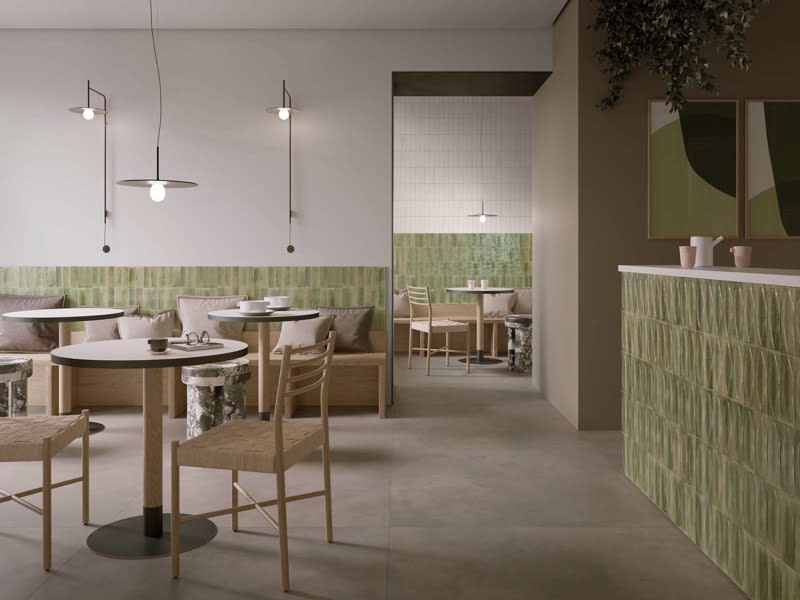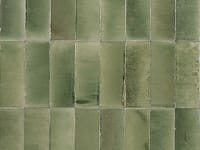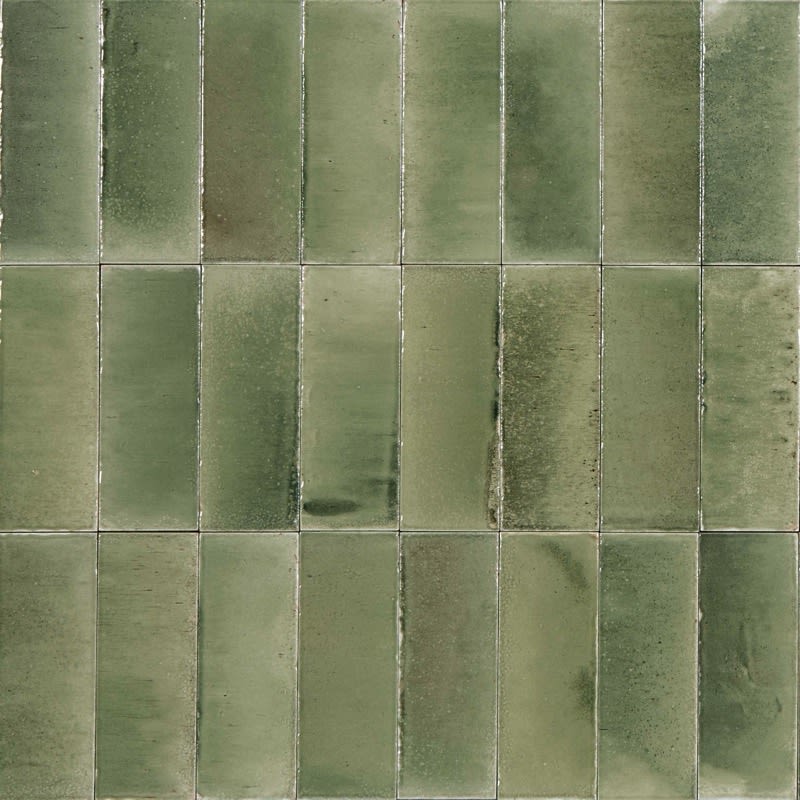Basket Preview





We will only supply a maximum of 1 Sample per product
Only 2 Samples available in total per customer
For more information please Contact Us or use our Sample Order Form
Giada is a truly beautiful tile, subtle green tones blend perfectly together, allowing both trade and retails customer to keep their projects on trend and well aligned with todays internal fashions.
All Gleeze tiles are manufactured to the highest tolerances allows for a 1mm joint to be achieved improving the overall appearance of the tile installation, but still giving slight edge imperfections associated with a hand crafted tile.
Our Gleeze range of Glazed Porcelain Tiles recalls the ceramic tradition of Hand-craftsmanship and ever-changing materials in which imperfection and defects are an added benefit. Clear shade transitions embellished with dripping rust and iron, irregularities typical of the artisan production process. Strong shading, chipping and relief imperfections give the collection an exclusive look to wrap spaces in a newfound naturalness.
Our latest research in the area of industrial craftsmanship has led to the rediscovery of the beauty of authentic, colourful, decorated ceramics in collections with a hand-made flavour, created by combining craft skills with industrial technology. represents unique levels of quality and aesthetics.
Together with a return to a human “feel” and human workmanship, and the care and attention typical of hand-made pieces. These materials give spaces vibrancy and a warm, welcoming mood, beyond styles and beyond time.
Gleeze is manufactured with a state-of-the-art production technology and drawing on in-depth research into glazes and colour, offers a stoneware evocation of the beauty of ultra-glossy hand-made majolica tiles, with their dense glaze and minor flaws: smears, irregularities, pitting and variations in shades and patterns make every piece, and the relative wall compositions, virtually unique.
Supplied in 200 x 70mm size and has exceptionally straight edges allowing almost joint-free installation, make this project decidedly contemporary. A porcelain body with a rich deep glaze comprising of over 60 graphic variants perfect for use in any application old , new , contemporary and classic , suitable for both residential and contract wall installations.
How many coats of oil you apply to your worktop after sanding and cleaning really depends on the product you are using, always follow full the manufacturers guidelines, but in most case two to three coats will be sufficient.
You would normally match the silicon you are using around the worktop to the tiles being used for the splash back. If you are not using tiles in most cases people either try to match to the worktop colour or go for stand white silicon.
If your wooden worktop is sticky after apply a surface treatment, you have over applied the product and in most cases you will need to wait for it to dry and then remove by re-sanded and then re-apply the treatment as thinly as is possible, more coats and much better than one thick coat.
You will only even need to clean your oak worktop with warm soapy water and a soft cloth, it's important to avoid using any abrasive cleaning products or scouring pads as these will damage the surface of the worktops and will greatly increase your long term maintenance requirements.
Firstly you will need to sand the whole of the existing worktop to remove any old treatment and scratches and stains, start off with 60 grit sandpaper working up to 220grit for the finished surface. When this has been achieved the surface needs to be fully cleaned and all dust removed so it’s ready for your chosen treatment.
If using Linseed or Danish oils, Pour a small amount of the oil directly onto the worktop surface and using the lint free cloth, spread it over the surface until you have a very thin and even layer that covers the whole of the worktop.
For hardwax oil follow the same process but use a suitable paint brush and ensure each coat is as thin as possible.
Once you have the thinnest possible layer of Wax or Oil, allow to fully dry before commencing a second coat, never over brush the wet surface.
If using Linseed or Danish oils, pour a small amount of the oil directly onto the worktop surface and using the lint free cloth, spread it over the surface until you have a very thin and even layer that covers the whole of the worktop.
For Hardwax oils follow the same process but use a suitable paint brush and ensure each coat is as thin as possible.
Once you have the thinnest possible layer of Wax or Oil, allow to fully dry before commencing a second coat, never over brush the wet surface.
We would always recommend using a Hardwax Oil for Kitchen worktops, such as Treatex Hardwax. These are a blend of natural oils and waxes that offer exceptional durability and are completely food safe, they are water repellent penetrate into the surface of the wood stopping any peeling or flaking.
Slate hearths can quite easily be scratched, these scratches are more visible on honed surfaces compared to natural riven, but they will just fade and disappear to some extend over time, or if you apply a coat of slate oil this will keep you hearth looking perfect even if under heavy use.
Yes we believe slate is the best material for Fireplace hearths and has been used for centuries with great success. Always look for a good quality slate supplier who is sourcing from either Brazilian quarries or if your budget will stretch from home grown Welsh slate Quarries. I would avoid any Chinese slate as the quality does not tend to be good enough and I would questions the longevity of the material.
Black slate is extremely easy to maintain and cleaning will generally consist of a dust pan and brush or a wet mop and soapy water if heavily soiled. On occasion you can apply a coat of Slate Oil to bring back the lustre of the natural slate, this will also offer some protection against staining.
In the UK market by far the most common material for Fireplace Hearths is Slate, we source our slate from Brazil as it offers an excellent surface finish and is strong enough to withstand the punishment of everyday use.
We would always recommend creating a plywood or cardboard template before starting to cut your Slate hearth blank. You need to fully measure all sides of the opening and establish what over hangs you are going to need to meet current building regs, link to guide below:
https://www.naturalstoneandtimber.co.uk/indoor-fireplace-hearth-installation
When you have transferred these measurements onto the plywood, cut this out carefully and then test this template in the fireplace opening to ensure you have correctly measured. When this is correct the template can be used to mark out the Slate ready for installation.
You have two options when it comes to bedding down your fire place hearth, you can go for traditional sand and cement mortar mixed at a ratio of 4 parts sand to 1 part cement or alternatively you can use a pre-mixed powered tile adhesive. If you need build up one end of the hearth to help with levelling, it sometimes might be easier with sand and cement mortar, as tile adhesives have a maximum depth.
When cutting Slate tiles, it is best to use a diamond blade, and preferably a good quality wet cut tile bench or 4 ½ inch angle grinder, ideally with water feed machinery to reduce the amount of dust produced and to provide a successful cut through the tiles.
Slate tiles can be laid the same way as standard ceramic or porcelain tiles, but with the exception of cutting which will require a wet cutting bench or grinder with a high quality diamond blade. For more information on slate tile installation please following the link below:
https://www.naturalstoneandtimber.co.uk/indoor-tiles-and-mosaics-installation
The thickness of slate tiles depends on what they are being used for, internally you will normally see tiles ranging in thickness between 8mm to 12mm, for external applications they will normally be between 20 – 25mm in thickness.
Yes slate tiles are extremely durable and make an excellent internal tile, it is important to use the correct finish tile in the correct place, honed / polished Slate tiles are not really suitable for floor installations as they can be easily scratched.
Polishing Slate tiles is a reasonably simple process, but you need experience to get good results. Basically, you need to use a Diamond floor polishing pad with a 800 Grit or higher. On slate you would firstly need to hone the surface of the tiles flat, before starting the polishing process, so polishing a Slate tile with a riven surface will not be possible.
How many slate tiles you get per square metre really does depend on the size of the tiles. Establish the width and length of the tiles in mm, multiply these together, this will give you the area of the tile, then divide 1 x this area and this will give you the amount per sqm. Example below:
600mm x 400mm size tiles (0.6 x 0.4 = 0.24). 1 / 0.24 = 4.166 giving you just over 4 tiles per sqm in this size
Slate tiles are a natural quarried product that is extracted in large blocks and then sawn to the desired size and naturally split by hand to the specified thickness required for the end use.
See our locations